
Created by Charles Babbage, the Analytical Engine was a general-purpose, completely program-controlled, mechanical digital computer with no human intervention. It was designed to be programmed using punched cards, something that was one of its most ground-breaking features. The Analytical Engine was intended to be large enough to contain 1,000 50-digit numbers, which was more than any computer constructed before 1960 could store.
Charles Babbage Analytical Engine History
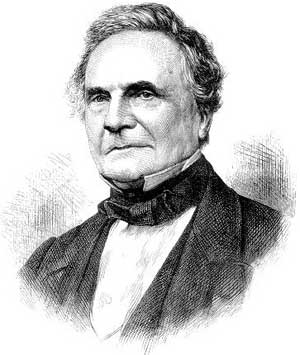
It seems like a marvel that the world’s first digital computer, which included about every key concept of the current digital computer in its mechanical and logical features, was created in the 1830s. The machine is the Analytical Engine, and the famous Charles Babbage created it.
Babbage made several changes to his first computer, the specialized Difference Engine, in 1834. When a new constant was needed in a series of computations, it had to be inserted by hand in the original design. Babbage devised a method of mechanically inserting the differences by placing the axes of the Difference Engine in a circular pattern, such that the result column would be near the last difference and therefore conveniently accessible. He dubs this design “the engine devouring its own tail” or “a locomotive laying down its track.”
But this rapidly led to the concept of using completely separate ways to operate the machine, allowing it to do addition and all arithmetic operations in whatever sequence and as many times as needed.
Unfortunately, Babbage did not get to see his Analytical Engine in action as he was still working on it when he died. Instead, his son, Henry Babbage, carried on with his work.
Charles Babbage Analytical Engine: How it Worked
The mill, the reader, the store, and the printer were all meant to be part of the machine. These are the most critical components of today’s computers. The mill was the calculating unit, similar to a current computer’s central processing unit (CPU); the store to store data before processing, parallel to memory and storage in modern computers; and the printer and reader were the input and output devices.
Like the Difference Engine, the project was significantly more sophisticated than anything developed before. It featured a “store” which was intended to be large enough to contain 1,000 50-digit numbers, more than any computer constructed before 1960 could store. The machine was to be operated by a single person and was to be steam-powered. Like the Difference Engine, the printing capabilities were ambitious: Babbage sought to automate the process as far as possible, all the way down to printing tables of numbers.
Another unique feature of the Analytical Engine was the reader. Babbage used the Jacquard loom’s card-reading technology to enter data (numbers) on punched cards. Instructions were to be written on cards, another notion inspired by Joseph-Marie Jacquard. It would be programmable and significantly more adaptable than any machine due to the usage of instruction cards. (In the translation of a French article on Analytical Engine in 1843, mathematician Ada Lovelace described how people might use the machine to follow a program to compute Bernoulli numbers.) She has been dubbed the “first computer programmer” due to this.)
Another feature of programmability was running instructions in any sequence other than sequential. It was supposed to have a decision-making capability in its conditional control transfer, also known as conditional branching, where it might jump to a different instruction based on the value of specified data. Unfortunately, many early computers in the twentieth century lacked this compelling function.
Charles Babbage Analytical Engine: Historical Significance
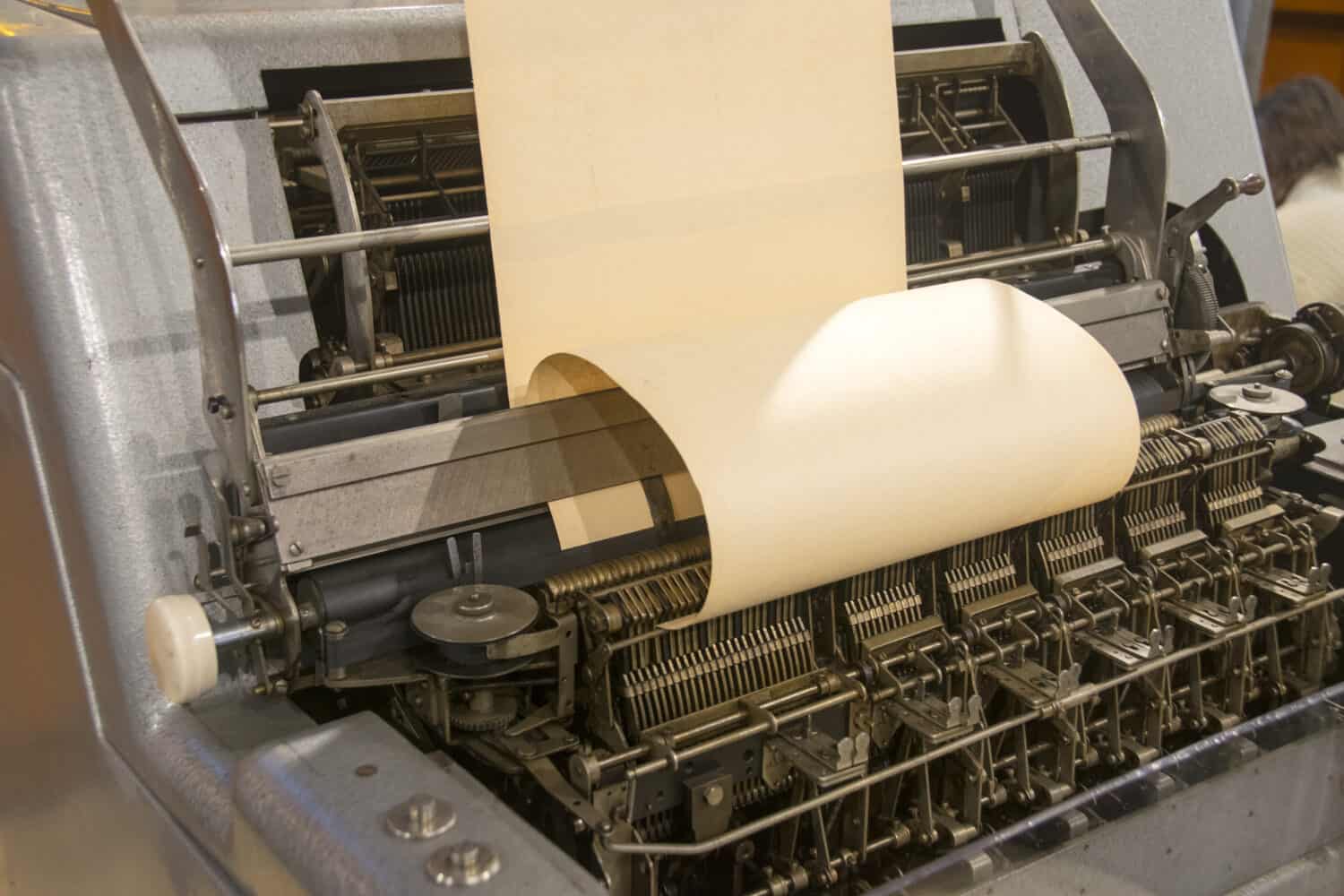
©Libor Píška/Shutterstock.com
The Analytical Engine was, by most standards, a real computer as we know it today—or would have been, had Babbage not fallen into technical issues again. However, constructing Babbage’s ambitious design was impossible given the present technology. Moreover, Babbage’s failure to create the promised mathematical tables with his Difference Engine had dimmed excitement for more government financing. Indeed, the British government could see that Babbage was more interested in creativity than building tables.
Regardless, Babbage’s Analytical Engine was a first in the world. Its most significant feature was modifying its operation by changing the instructions on punched cards. All mechanical calculators or glorified calculators, such as the Difference Engine, were available until this innovation. The Analytical Engine was the first machine that deserved a computer, even though Babbage never completed it.
The object of the machine may shortly be given thus (according to Henry Babbage, the youngest son of the inventor):
It is a machine to calculate the numerical value or values of any formula or function of which the mathematician can indicate the method of solution. It is to perform the ordinary rules of arithmetic in any order as previously settled by the mathematician, and any number of times and on any quantities. It is to be absolutely automatic, the slave of the mathematician, carrying out his orders and relieving him from the drudgery of computing. It must print the results, or any intermediate result arrived at.
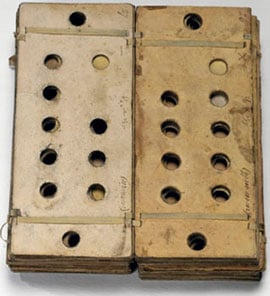
Babbage intended to design a machine with a repertoire of the four basic arithmetic functions, in contrast with the Difference Engine, which is using only addition. On the analogy of a modern digital computer, the design principle of the Analytical Engine can be divided to:
1. Input: From 1836 on, punched cards (see the nearby photo) were the basic mechanism for feeding into the machine both numerical data and the instructions on how to manipulate them.
2. Output: Babbage’s basic mechanism was always a printing apparatus, but he had also considered graphic output devices even before he adopted punched cards for output as well as input.
3. Memory: For Babbage this was basically the number axes in the store, though he also developed the idea of a hierarchical memory system using punched cards for additional intermediate results that could not fit in the store.
4. Central Processing Unit: Babbage called this the Mill. Like modern processors it provided for storing the numbers being operated upon most immediately (registers); hardware mechanisms for subjecting those numbers to the basic arithmetic operations; control mechanisms for translating the user-oriented instructions supplied from outside into detailed control of internal hardware; and synchronization mechanisms (a clock) to carry out detailed steps in a carefully timed sequence. The control mechanism of the Analytical Engine must execute operations automatically and it consists of two parts: the lower level control mechanism, controlled by massive drums called barrels, and the higher level control mechanism, controlled by punched cards, developed by Jacquard for pattern-weaving looms and used extensively in the beginning of 1800s.
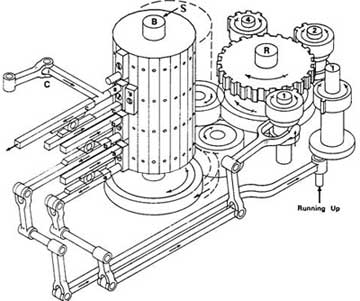
The sequence of smaller operations required to effect an arithmetical operation was controlled by massive drums called barrels (see the nearby figure). The barrels had studs fixed to their outer surface in much the same way as the pins of a music box drum or a barrel organ. The barrels orchestrated the internal motions of the engine and specify in detail how multiplication, division, addition, subtraction, and other arithmetic operations, are to be carried out.
The barrel shown in the illustration has only several stud positions in each vertical row. In the actual machine, the barrels were much larger because they controlled and coordinated the interaction of thousands of parts. Each row could contain as many as 200 stud positions, and each barrel could have 50 to 100 separate rows. The overall machine had several different barrels controlling different sections. Naturally, the barrels had to be closely coordinated with one another. As a barrel turned, the studs activated specific motions of the mechanism and the position and arrangement of the studs determined the action and relative timing of each motion.
The act of turning the drum thus automatically executed a sequence of motions to carry out the desired higher level operation. The process is internal to the Engine and logically invisible to the user. The technique is what in computing is now called a microprogram (though Babbage never used this term), which ensures that the lower level operations required to perform a function are executed automatically.
For higher level control mechanism, Babbage initially intended to use a big central barrel, to specify the steps of a calculation. This idea however seems impractical, because this will require changing the studs on the super barrel, which could be a cumbersome operation. The task of manually resetting studs in the central drum to tell the machine what to do was too cumbersome and error-prone to be reliable. Worse, the length of any set of instructions would be limited by the size of the drum.
His struggle with the problem of control led Babbage to a real breakthrough on June 30, 1836. He conceived of providing instructions and data to the engine not by turning number wheels and setting studs, but by means of punched card input, by means of cards, similar to these, used in the Jacquard looms. This did not render the central drum obsolete nor replace it. Punched cards provided a new top level of the control hierarchy that governed the positioning of the central drum. The central drum remained, but now with permanent sequences of instructions.
It took on the function of micro-programming, as this of other barrels. If there were separate barrels for each operation, and a central barrel for controlling the operations drums, the punched card presents a way of instructing the machine (the central drum) as to which operations we wished to perform and in what order, i.e. high-level programming the Engine.
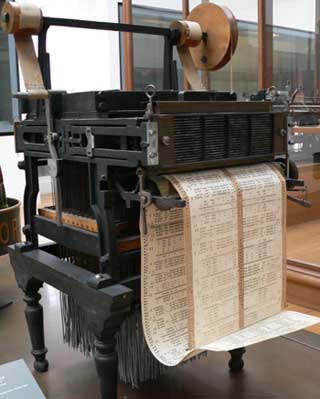
The principle of cards was openly borrowed from the Jacquard loom (a mechanical loom, invented by the Frenchman Joseph Marie Jacquard in the beginning of 1800s, based on earlier inventions of his compatriots Basile Bouchon (1725), Jean Falcon (1728) and Jacques Vaucanson (1740)), which used a string of punched cards to automatically control the pattern of a weave (see the nearby photo).
In the loom, rods were linked to wire hooks, each of which could lift one of the longitudinal threads strung between the frame. The rods were gathered in a rectangular bundle, and the cards were pressed one at a time against the rod ends.
If a hole coincided with a rod, then the rod passed through the card and no action was taken. If no hole was present then the card pressed back the rod to activate a hook which lifted the associated thread, allowing the shuttle which carried the cross-thread to pass underneath. The cards were strung together with wire, ribbon or tape hinges, and fan, folded into large stacks to form long sequences. The looms were often massive and the loom operator sat inside the frame, sequencing through the cards one at a time by means of a foot pedal or hand lever. The arrangement of holes on the cards determined the pattern of the weave.
After finishing of the work on the design of the Analytical Engine in 1847, Babbage turned to the design of a Difference Engine №2, exploiting the improved and simplified arithmetic mechanisms developed for the Analytical Engine. In 1857 Babbage returned to the design of the Analytical Engine. In this new phase of work Babbage was actively interested in building an Analytical Engine with his own resources. The logical design was somewhat simplified but, most importantly, far simpler and cheaper methods were proposed to implement the basic mechanisms.
Babbage first experimented with sheet metal stamping and pressing for making gear wheels and similar parts. Later, he adopted pressure die casting for making parts—a newly invented technique that did not see extensive commercial use until the end of the nineteenth century. Babbage built many experimental models of mechanisms using these new techniques, and, at the time of his death in 1871, a model of a simple mill and printing mechanism was near completion (see the lower photo).
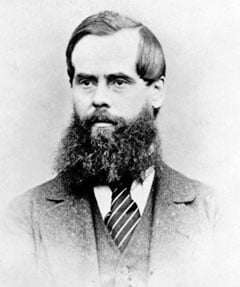
Babbage’s calculating machines, as well as all related materials were inherited by his youngest survived son, Major-General Henry Prevost Babbage (1824-1918) (see the nearby image), who had shown a strong interest in his father’s work. Even as teenagers Henry and his older brother Dugald spent time in Babbage’s drawing office and workshop learning workshop skills. Henry later acquired a strong grasp of the Difference Engine and Analytical Engine designs, and came to form a close bond with his father whom he visited on furlough from extended military service in India. Babbage bequeathed his drawings, workshop and the surviving physical relics of the engines to Henry who tried to continue his father’s work and to publicize the engines after Babbage’s death.
Henry was at his father’s bedside when Babbage died in October, 1871, and from 1872 he continued diligently with his father’s work and then intermittently in retirement in 1875. After assembling some small demonstration pieces for Difference Engine Number 1 (one of them he sent to Harvard. In the 1930s the piece attracted the attention of Howard Aiken, the creator of the Harvard Mark I).
In 1888, Henry demonstrated on a meeting of British Association for the Advance of Science a section of the Mill of the Analytical Engine, working to 29 digits, including the anticipatory carry device.
Then Henry built an experimental four-function calculator for the Mill, completing it in 1910. Henry actually decided not to continue with the original design of the Analytical Engine, but instead to develop a manually operated machine for addition, subtraction, multiplication, and division (a four-function calculator), incorporating the mechanisms planned for the mill and printing mechanism of the Engine (see the lower photo). Using the assembled Mill of Analytical Engine, he would do simple calculations—in this case produce multiples of π.

A part of the mill and printing mechanism of the Analytical Engine, constructed by Henry Babbage
Although eventually completed in the beginning of the twentieth century, when Henry was himself an old man, this machine appears never to have worked reliably. Moreover, Henry’s work on the engines was sound, but without the boldness and inspiration of his father, the great Charles Babbage.